Places To Visit
Naqsh-e Jahan Square
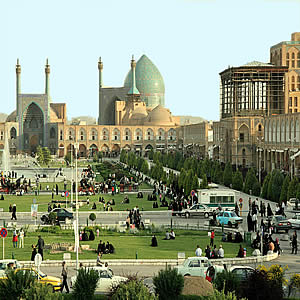 Naqsh-e Jahan Square the second biggest square in the world, after Beijing's Tiananmen situated at the center of Isfahan, Iran. Constructed between 1598 and 1629, it is now an important historical site, and one of UNESCO's World Heritage Sites. It is 160 metres (520 ft) wide by 560 metres (1,840 ft) long (an area of 89,600 square metres (964,000 sq ft)). It is also referred to as Shah Square or Imam Square. The square is surrounded by buildings from the Safavid era. The Shah Mosque is situated on the south side of this square. On the west side is the Ali Qapu Palace. Sheikh Lotf Allah Mosque is situated on the eastern side of this square and at the northern side Qeysarie Gate opens into the Isfahan Grand Bazaar.
Naqsh-e Jahan Square the second biggest square in the world, after Beijing's Tiananmen situated at the center of Isfahan, Iran. Constructed between 1598 and 1629, it is now an important historical site, and one of UNESCO's World Heritage Sites. It is 160 metres (520 ft) wide by 560 metres (1,840 ft) long (an area of 89,600 square metres (964,000 sq ft)). It is also referred to as Shah Square or Imam Square. The square is surrounded by buildings from the Safavid era. The Shah Mosque is situated on the south side of this square. On the west side is the Ali Qapu Palace. Sheikh Lotf Allah Mosque is situated on the eastern side of this square and at the northern side Qeysarie Gate opens into the Isfahan Grand Bazaar.
Naqsh-e Jahan Square or Imam Square is still used for performing ceremonies and parades on special occasions. There are Traditional shops all around the square for you to explore. Also, Carriage rides are a wonderful way to experience the beauty of the Naqsh-e Jahan Square.
Ali Qapu
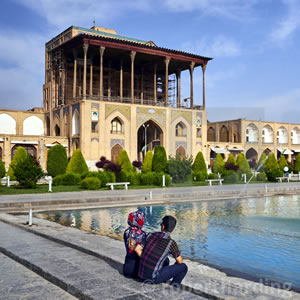 Ali Qapu is a grand palace in Isfahan, Iran. It is located on the western side of the Naqsh e Jahan Square, opposite to Sheikh Lotfollah Mosque, and had been originally designed as a vast portal. It is forty-eight meters high and there are six floors, each accessible by a difficult spiral staircase. In the sixth floor, Music Hall, deep circular niches are found in the walls, having not only aesthetic value, but also acoustic.
Ali Qapu is a grand palace in Isfahan, Iran. It is located on the western side of the Naqsh e Jahan Square, opposite to Sheikh Lotfollah Mosque, and had been originally designed as a vast portal. It is forty-eight meters high and there are six floors, each accessible by a difficult spiral staircase. In the sixth floor, Music Hall, deep circular niches are found in the walls, having not only aesthetic value, but also acoustic.
Ali Qapu is rich in naturalistic wall paintings by Reza Abbasi, the court painter of Shah Abbas I, and his pupils. There are floral, animal, and bird motifs in his works. The highly ornamented doors and windows of the palace have almost all been pillaged at times of social anarchy. Only one window on the third floor has escaped the ravages of time. Ali Qapu was repaired and restored substantially during the reign of Shah Sultan Hussein.
Sheikh Lotfollah Mosque
 Is one of the architectural masterpieces of Iranian architecture that was built during the Safavid Empire, standing on the eastern side of Naqsh-i Jahan Square, Esfahan, Iran. Construction of the mosque started in 1603 and was finished in 1619. It was built by the chief architect Shaykh Bahai, during the reign of Shah Abbas I of Persia. On the advice of Arthur Upham Pope, Reza Shah Pahlavi had the mosque rebuilt and repaired in the 1920s.
Is one of the architectural masterpieces of Iranian architecture that was built during the Safavid Empire, standing on the eastern side of Naqsh-i Jahan Square, Esfahan, Iran. Construction of the mosque started in 1603 and was finished in 1619. It was built by the chief architect Shaykh Bahai, during the reign of Shah Abbas I of Persia. On the advice of Arthur Upham Pope, Reza Shah Pahlavi had the mosque rebuilt and repaired in the 1920s.
The purpose of this mosque was for it to be private to the royal court (unlike the Shah Mosque, which was meant for the public).[3] For this reason, the mosque does not have any minarets and is smaller. Indeed, few Westerners at the time of the Safavids even paid any attention to this mosque, and they certainly did not have access to it. It was not until centuries later, when the doors were opened to the public, that ordinary people could admire the effort that Shah Abbas had put into making this a sacred place for the ladies of his harem, and the exquisite tile-work, which is far superior to that covering the Shah Mosque.
Masjed-e Jame
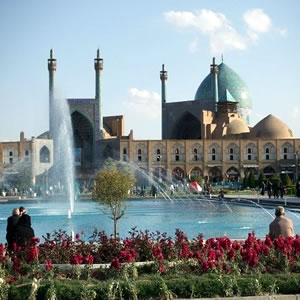 This is one of the oldest mosques still standing in Iran,The origins of this mosque lie in the 8th century, but it burnt down and was rebuilt again in the 11th century during the Seljuk dynasty and went through remodeling many times. As a result, it has rooms built in different architectural styles, so now the mosque represents a condensed history of Iranian Architecture.The main sanctuary is entered via the south iwan. It is worth finding a quiet corner here to sit and contemplate the richness of the domed ceiling, with its golden rose pattern (the flower basket) surrounded by concentric circles of busy mosaics on a deep blue background. The interior ceiling is 36.3m high, but the exterior reaches up to 51m due to the double layering used in construction. The hollow space in between is responsible for the loud echoes heard when you stamp your foot on the black paving stones under the centre of the dome. Although scientists have measured up to 49 echoes, only about 12 are audible to the human ear – more than enough for a speaker to be heard throughout the mosque. The marble mihrab and minbar (pulpit of a mosque) are also beautifully crafted.
The main sanctuary provides wonderful views of the two turquoise minarets above the entrance portal. Each is encircled by projecting balconies and white geometric calligraphy in which the names of Mohammed and Ali are repeated almost ad infinitum. To the east and west of the main sanctuary are the courtyards of two madrasehs. Both provide good views of the main dome with its glorious profusion of turquoise-shaded tiles.
This is one of the oldest mosques still standing in Iran,The origins of this mosque lie in the 8th century, but it burnt down and was rebuilt again in the 11th century during the Seljuk dynasty and went through remodeling many times. As a result, it has rooms built in different architectural styles, so now the mosque represents a condensed history of Iranian Architecture.The main sanctuary is entered via the south iwan. It is worth finding a quiet corner here to sit and contemplate the richness of the domed ceiling, with its golden rose pattern (the flower basket) surrounded by concentric circles of busy mosaics on a deep blue background. The interior ceiling is 36.3m high, but the exterior reaches up to 51m due to the double layering used in construction. The hollow space in between is responsible for the loud echoes heard when you stamp your foot on the black paving stones under the centre of the dome. Although scientists have measured up to 49 echoes, only about 12 are audible to the human ear – more than enough for a speaker to be heard throughout the mosque. The marble mihrab and minbar (pulpit of a mosque) are also beautifully crafted.
The main sanctuary provides wonderful views of the two turquoise minarets above the entrance portal. Each is encircled by projecting balconies and white geometric calligraphy in which the names of Mohammed and Ali are repeated almost ad infinitum. To the east and west of the main sanctuary are the courtyards of two madrasehs. Both provide good views of the main dome with its glorious profusion of turquoise-shaded tiles.
Kakh-e Chehel Sotun
 Built as a pleasure pavilion and reception hall, using the Achaemenid-inspired talar (columnar porch) style, this beautifully proportioned palace is entered via an elegant terrace that perfectly bridges the transition between the Persian love of gardens and interior splendour. The 20 slender, ribbed wooden pillars of the palace rise to a superb wooden ceiling with crossbeams and exquisite inlay work. Chehel Sotun means ‘40 pillars’ – the number reflected in the long pool in front of the palace.The only surviving palace on the royal precinct that stretched between Naqsh-e Jahan (Imam) Sq and Chahar Bagh Abbasi St, this Safavid-era complex is reputed to date from 1614; an inscription uncovered in 1949, however, says it was completed in 1647 under the watch of Shah Abbas II. Either way, the palace on this site today was rebuilt after a fire in 1706.
Built as a pleasure pavilion and reception hall, using the Achaemenid-inspired talar (columnar porch) style, this beautifully proportioned palace is entered via an elegant terrace that perfectly bridges the transition between the Persian love of gardens and interior splendour. The 20 slender, ribbed wooden pillars of the palace rise to a superb wooden ceiling with crossbeams and exquisite inlay work. Chehel Sotun means ‘40 pillars’ – the number reflected in the long pool in front of the palace.The only surviving palace on the royal precinct that stretched between Naqsh-e Jahan (Imam) Sq and Chahar Bagh Abbasi St, this Safavid-era complex is reputed to date from 1614; an inscription uncovered in 1949, however, says it was completed in 1647 under the watch of Shah Abbas II. Either way, the palace on this site today was rebuilt after a fire in 1706.
The Great Hall (Throne Hall) is a gem, richly decorated with frescoes, miniatures and ceramics. The upper walls are dominated by historical frescoes on a grand scale, sumptuously portraying court life and some of the great battles of the Safavid era – the two middle frescoes (Nos 114 and 115) date from the Qajar period but the other four are original. From right to left, above the entrance door, the armies of Shah Ismail do battle with the Uzbeks; Nader Shah battles Sultan Mohammed (astride a white elephant) on an Indian battleground; and Shah Abbas II welcomes King Nader Khan of Turkestan with musicians and dancing girls.
Isfahan Bazaar
 Indulge yourself in what the centuries-old bazaar has to offer. The lively atmosphere of the shops and shoppers, the gleaming handicrafts, the music of the hammers and copper plates mixed pleasantly with the strong hum of the crowd under the arched roofs. Heavenly light penetrates here and there from the centre of the arches giving the floating particles a magical slow-motion effect. Whether you are here for colours, for music, for history, for photography or just her for a new experience with new people and culture, this place is the right place. Perfect for humans-of-newyork style photography. A rainbow selection of spices for gastro lovers. A tour of the old bazaar of Isfahan is a complete package in itself. Given that it’s located adjacent to the Naghsh e Jahan Square with its significant historical monuments it gives you the false impression that the visit is doable in one day which might not be the best thing to do.
Indulge yourself in what the centuries-old bazaar has to offer. The lively atmosphere of the shops and shoppers, the gleaming handicrafts, the music of the hammers and copper plates mixed pleasantly with the strong hum of the crowd under the arched roofs. Heavenly light penetrates here and there from the centre of the arches giving the floating particles a magical slow-motion effect. Whether you are here for colours, for music, for history, for photography or just her for a new experience with new people and culture, this place is the right place. Perfect for humans-of-newyork style photography. A rainbow selection of spices for gastro lovers. A tour of the old bazaar of Isfahan is a complete package in itself. Given that it’s located adjacent to the Naghsh e Jahan Square with its significant historical monuments it gives you the false impression that the visit is doable in one day which might not be the best thing to do.
Khaju Bridge
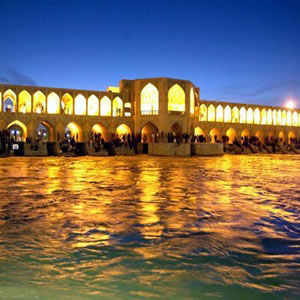 Khaju Bridge is one of the most famous bridges in Iran. As well as being a bridge and weir, this bridge functions as a building and a place for public meetings. It is decorated with paintings and tileworks. It is a thorough sample of Persian architecture. After 350 years of being construEleven bridges cross the Zayandeh River in Isfahan (Esfahan). Six of these are modern constructions but the other five crossings date from the Safavid period.
Except for the shorter Marnan Bridge (Pol-e Marnam), the other historic bridges lie to the east of Chahar Bagh Street.
The 298m Si-o-Seh Bridge (Pol-e Si-o-Seh) which is known as the Bridge of 33 Arches or Allahverdi Khan Bridge. Allahverdi Khan, a general of Shah Abbas , completed the bridge in 1602 and the structure acts both as a crossing and a dam.
The Shahrestan Bridge with much of the stone and brick structure of the 11-arch bridge dating from the 12th century.
Moving west again is the 150m, 21-arch Chubi Bridge built in 1665 by Shah Abbas.
3km to the west, the Khaju Bridge built in the mid-17th century by Shah Abbas also serves as a dam of the river.
There is a famous teahouse at the northern end of the bridge.Trolling along the river with stops at the many teahouses near the ancient bridges is a pleasant way to spend time in Isfahan. The bridges themselves are illuminated at night.
Khaju Bridge is one of the most famous bridges in Iran. As well as being a bridge and weir, this bridge functions as a building and a place for public meetings. It is decorated with paintings and tileworks. It is a thorough sample of Persian architecture. After 350 years of being construEleven bridges cross the Zayandeh River in Isfahan (Esfahan). Six of these are modern constructions but the other five crossings date from the Safavid period.
Except for the shorter Marnan Bridge (Pol-e Marnam), the other historic bridges lie to the east of Chahar Bagh Street.
The 298m Si-o-Seh Bridge (Pol-e Si-o-Seh) which is known as the Bridge of 33 Arches or Allahverdi Khan Bridge. Allahverdi Khan, a general of Shah Abbas , completed the bridge in 1602 and the structure acts both as a crossing and a dam.
The Shahrestan Bridge with much of the stone and brick structure of the 11-arch bridge dating from the 12th century.
Moving west again is the 150m, 21-arch Chubi Bridge built in 1665 by Shah Abbas.
3km to the west, the Khaju Bridge built in the mid-17th century by Shah Abbas also serves as a dam of the river.
There is a famous teahouse at the northern end of the bridge.Trolling along the river with stops at the many teahouses near the ancient bridges is a pleasant way to spend time in Isfahan. The bridges themselves are illuminated at night.
Atashgah (Zoroastrian Fire Temple of Isfahan)
 The circular tower at the top of the Maras or Marbin hill is the signature monument of this place. This circular fire altar is five meters in diameter which is surrounded by a wall cut with eight windows. This structure had a tall dome to protect the fire. The building main material is mud-brick made with clay, lime and long stems of reeds. In some parts of the construction the thickness of the walls exceeds four meters. It was clarified that the whole area of the hill was covered by a five-storey huge building which the fifth and the forth storeys still remain. In the history book written by Ibne Rosteh Esfahani, it was stated that Atashgah was originally used as a castle. The name Marbin castle is related to the word Mehre meaning the sun which hints to the place where one can see the sun better. It can also relate to the word Mar meaning snake that can relate to the shape of the river crawling as if a serpent creeping on the ground.back to top
The circular tower at the top of the Maras or Marbin hill is the signature monument of this place. This circular fire altar is five meters in diameter which is surrounded by a wall cut with eight windows. This structure had a tall dome to protect the fire. The building main material is mud-brick made with clay, lime and long stems of reeds. In some parts of the construction the thickness of the walls exceeds four meters. It was clarified that the whole area of the hill was covered by a five-storey huge building which the fifth and the forth storeys still remain. In the history book written by Ibne Rosteh Esfahani, it was stated that Atashgah was originally used as a castle. The name Marbin castle is related to the word Mehre meaning the sun which hints to the place where one can see the sun better. It can also relate to the word Mar meaning snake that can relate to the shape of the river crawling as if a serpent creeping on the ground.back to top
Monar Jonban
 The historic monument belonging to the Mongol time, known as Monar Jonban, is a shrine over the tombstone of Amu (Uncle) Abdollah. Monar Jonban is considered as one of the most popular monuments of Isfahan for its wonderful architecture. It is located in far west of Isfahan. the twin symmetric minarets are more than a masterpiece. The High architectural knowledge of its architects is reflected in the mysterious structure of the minarets.
The main distinguished feature of this monument is that by shaking strongly one minaret, the other minaret starts shaking with the same frequency. it also can be felt in the whole structure slightly. According to the latest research that has been done, the reason that the other minaret vibrates automatically after the other one is shaken is the “U-shape” structure of the building. There are also other points of view to this matter but the mystery is still unsolved.
The historic monument belonging to the Mongol time, known as Monar Jonban, is a shrine over the tombstone of Amu (Uncle) Abdollah. Monar Jonban is considered as one of the most popular monuments of Isfahan for its wonderful architecture. It is located in far west of Isfahan. the twin symmetric minarets are more than a masterpiece. The High architectural knowledge of its architects is reflected in the mysterious structure of the minarets.
The main distinguished feature of this monument is that by shaking strongly one minaret, the other minaret starts shaking with the same frequency. it also can be felt in the whole structure slightly. According to the latest research that has been done, the reason that the other minaret vibrates automatically after the other one is shaken is the “U-shape” structure of the building. There are also other points of view to this matter but the mystery is still unsolved.
Vank Cathedral
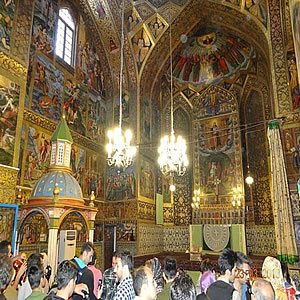 This church is located in Jolfa which is the Armenian district of Isfahan. Iranian architecture is mixed with Armenian architecture in Vank Cathedral. What make this church so different from anywhere in the world are the paintings inside the chapel. The prayer hall holds a unique collection of beautiful frescos depicting stories from the holy bible and Tora painted by Armenian artists during safavid era.
The museum inside the church contains exhibits of holy books such as the smallest scripture in the world. There is also a piece of hair with written words on it which you can look at it through a microscope.
This church is located in Jolfa which is the Armenian district of Isfahan. Iranian architecture is mixed with Armenian architecture in Vank Cathedral. What make this church so different from anywhere in the world are the paintings inside the chapel. The prayer hall holds a unique collection of beautiful frescos depicting stories from the holy bible and Tora painted by Armenian artists during safavid era.
The museum inside the church contains exhibits of holy books such as the smallest scripture in the world. There is also a piece of hair with written words on it which you can look at it through a microscope.
Shahi Assar Khaneh Museum
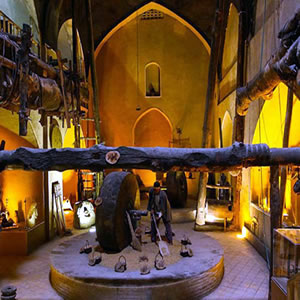 In the past, to summarize the procedure, dry grains such as cotton, apical, lines, sunflower, poppy, castor, and wild rocket seeds were brought here to be fried and then they were grinded with a grinding stone carried by a camel. After that, the powder was soaked in water. The final procedure was to pour the oil inside a pot which was then placed in special places carved in the walls. These places worked as a refrigerator. The domed structure of the place is actually for the purpose of cooling down the place. On top of that, walls and the ceiling are made of brick for the same purpose.
In the past, to summarize the procedure, dry grains such as cotton, apical, lines, sunflower, poppy, castor, and wild rocket seeds were brought here to be fried and then they were grinded with a grinding stone carried by a camel. After that, the powder was soaked in water. The final procedure was to pour the oil inside a pot which was then placed in special places carved in the walls. These places worked as a refrigerator. The domed structure of the place is actually for the purpose of cooling down the place. On top of that, walls and the ceiling are made of brick for the same purpose.
There used to be many oil factory houses and AssarKhaneh around Isfahan but today, this is the only one that has remained.
Si-O-Seh Pol Bridge
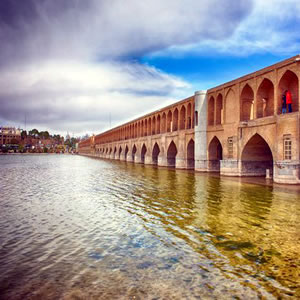 The historical Si-o-Seh Pol bridge is the largest hydraulic structure in Iran. It is 295 m long and 14 m wide. The construction of this bridge dates back to Safavid era. Shah Abbas the first ordered the building of this bridge.Set on the zayanderood river, this bridge connects the northern part of Chahar Bagh Abbasi street to its southern part. Actually, this was the main role of the bridge in the first place. The reason behind its being the longest bridge is that it was constructed over the widest part of the river.Si-o-Seh is the number 33 in Farsi/Persian. It was named after its defining feature which is the 33 arches it has over the river. This bridge is also famously known as Chehel Cheshmeh Bridge and Allahverdi Khan Bridge.
The historical Si-o-Seh Pol bridge is the largest hydraulic structure in Iran. It is 295 m long and 14 m wide. The construction of this bridge dates back to Safavid era. Shah Abbas the first ordered the building of this bridge.Set on the zayanderood river, this bridge connects the northern part of Chahar Bagh Abbasi street to its southern part. Actually, this was the main role of the bridge in the first place. The reason behind its being the longest bridge is that it was constructed over the widest part of the river.Si-o-Seh is the number 33 in Farsi/Persian. It was named after its defining feature which is the 33 arches it has over the river. This bridge is also famously known as Chehel Cheshmeh Bridge and Allahverdi Khan Bridge.
Isfahan Music Museum
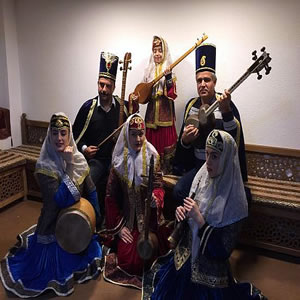 The Isfahan Music Museum is the first private one of its kind in Iran. The Museum was founded by two passionate Iranian musicians of the traditional music, Mehrdad Jeihooni and Shahriar Shokrani. It was inaugurated on the 2nd of December 2015. In 2016, the Museum obtained the first grade on the index for technical principles and physical standards from ICOM (International Council of Museums) IRAN. In the same year the Museum received the title of Best Privately Organized Museum in the country from the Cultural Heritage, Handicrafts and Tourism Organization of Iran.
The Isfahan Music Museum is the first private one of its kind in Iran. The Museum was founded by two passionate Iranian musicians of the traditional music, Mehrdad Jeihooni and Shahriar Shokrani. It was inaugurated on the 2nd of December 2015. In 2016, the Museum obtained the first grade on the index for technical principles and physical standards from ICOM (International Council of Museums) IRAN. In the same year the Museum received the title of Best Privately Organized Museum in the country from the Cultural Heritage, Handicrafts and Tourism Organization of Iran.
Isfahan Birds Garden
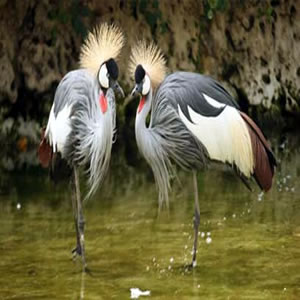 It was founded in 1998 by Isfahan Municipality. It is located in a garden which is about 55000 square meters, located in Najvan Park area, at bank of Zayandeh RoodRiver. The birds’ tent is about 17000 square meters. The tent is situated on 16 moveable pillars. The tent is 32 meters high and birds live under this huge tent.
It was founded in 1998 by Isfahan Municipality. It is located in a garden which is about 55000 square meters, located in Najvan Park area, at bank of Zayandeh RoodRiver. The birds’ tent is about 17000 square meters. The tent is situated on 16 moveable pillars. The tent is 32 meters high and birds live under this huge tent.
It is one of the most beautiful places, which is visited by local citizens and domestic tourists. It is an ideal place for children to see birds, local birds and various birds brought from different countries. Natural environment has been provided for birds.
Chahar Bagh Complex
 Chahar Bagh Complex is a master piece of architecture, comprised of three main monuments which are Chahar Bagh school, Bazaar of Art and a Caravanserai. Certainly, this complex is exquisite in the history of architecture.Chahar Bagh School is named after the last Safavid king, Shah Sultan Hossein. In some European travel records this school is mentioned as Madrasah Madar-Shah (king’s mother’s school). Although, there is no legitimate written claim of this fact. This monument is considered as the last one of the Safavid era. The school is a master piece of tile work with a garden-like appearance. It has four iwans with 121 rooms. Today, this monument houses a theological college. The Safavid king himself had a room there which he used for his studies. The room is open to visitors. It is equipped with king’s furniture and belongings.In the center of the courtyard there is a marble pool which is filled with the water that comes from one of the branches of Zayand-e Rud river. This school is actually a part of a splendid complex with a Caravanserai and the Bazaar of Art.
Chahar Bagh Complex is a master piece of architecture, comprised of three main monuments which are Chahar Bagh school, Bazaar of Art and a Caravanserai. Certainly, this complex is exquisite in the history of architecture.Chahar Bagh School is named after the last Safavid king, Shah Sultan Hossein. In some European travel records this school is mentioned as Madrasah Madar-Shah (king’s mother’s school). Although, there is no legitimate written claim of this fact. This monument is considered as the last one of the Safavid era. The school is a master piece of tile work with a garden-like appearance. It has four iwans with 121 rooms. Today, this monument houses a theological college. The Safavid king himself had a room there which he used for his studies. The room is open to visitors. It is equipped with king’s furniture and belongings.In the center of the courtyard there is a marble pool which is filled with the water that comes from one of the branches of Zayand-e Rud river. This school is actually a part of a splendid complex with a Caravanserai and the Bazaar of Art.
Sadr Historical Guest Home
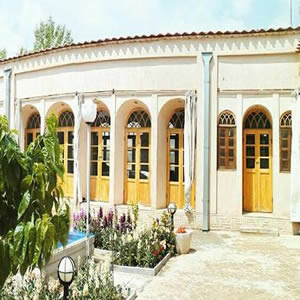 Sadr Historical Guest Home sits in one and half acres of wooded grounds with a delightful garden. With a rose garden, a long herbaceous border and, for our chef, a well-stocked kitchen garden.The Sadr home has an amazing view from balcony faces the rice filed vast valley and mountain range and it is within short walking distance to the great Zayandeh river.The home is located in village of Ismail Tarkhan 45 kilometers south-west of Isfahan in province of Mobarakeh and is accessible through express way 51 from Isfahan in which it will only takes 40 minutes to arrive.
Sadr Historical Guest Home sits in one and half acres of wooded grounds with a delightful garden. With a rose garden, a long herbaceous border and, for our chef, a well-stocked kitchen garden.The Sadr home has an amazing view from balcony faces the rice filed vast valley and mountain range and it is within short walking distance to the great Zayandeh river.The home is located in village of Ismail Tarkhan 45 kilometers south-west of Isfahan in province of Mobarakeh and is accessible through express way 51 from Isfahan in which it will only takes 40 minutes to arrive.
Whether it is your first visit to Isfahan or you wish to explore Isfahan province, there are always so many attractions just waiting to be discovered. Sadr Historical Guest Home is well located for this purpose. We can orgenize tours specially tailored so that you get the very best out of this historic city.back to top

